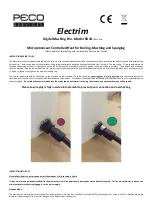
11
Parts & Service: 020 8988 7400 / E-mail: [email protected] or [email protected]
TIG WELDING
TIG welding is primarily for very thin materials. It uses a non-consumable
tungsten (or tungsten alloy) electrode, held in a torch.
A shielding gas (100% Argon), is fed through the torch to protect:
• The electrode,
• Molten weld pool,
• Solidifying weld metal from contamination by the atmosphere.
The electric arc is produced by the passage of current through the
conductive, ionized shielding gas. The arc is established between the tip of the
electrode and the work. Heat generated by the arc melts the base metal.
Once the arc and weld pool are established, the torch is moved along the
joint and the arc progressively melts the joined surfaces. Filler wire, if used, is
usually added to the leading edge of the weld pool to fill the joint.
This process is ideally suited for welding thin metals such as car body panels,
pressure vessels, heat exchangers, pipes etc., where accuracy and a high
quality weld is desired, as it produces a very low porosity weld.
MAIN FEATURES OF TIG WELDING
1. Electronic control of welding current.
2. Forced air cooling.
3. A thermal overload protection device prevents overheating.
TIG WELDING PROCESS ADVANTAGES
• It produces superior quality welds, generally free of defects.
• It is free of the spatter which occurs with other arc welding processes.
• It can be used with or without filler metal as required.
• It allows excellent control of root pass weld penetration.
• It can produce welds at high speeds.
• It allows precise control of the welding variables.
• It is capable of welding very thin material (0.5mm), without undue
distortion.
LIMITATIONS
1. Greater weld dexterity is required.
2. These units have a DC output which is not suitable for welding aluminium.










































